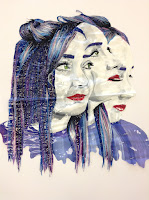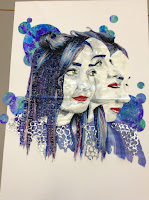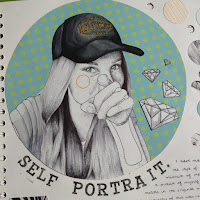
To begin my final piece, I enlarged my most successful biro portrait of Fran large enough to fit my PVC sheet. I pieced together the images to create the final large size with masking tape, so I was able to see the line work beneath and avoid damaging any of the materials I was using.
I used a permanent fine-liner to outline key areas of the portrait which wouldn't be as clear or defined in the paint.

 As I added more and more layers and tones to the skin, I also started to experiment with the highlights in the hair, which also started off with white and very pale strands which were thin and delicate to create depth and detail in the overall image.
As I added more and more layers and tones to the skin, I also started to experiment with the highlights in the hair, which also started off with white and very pale strands which were thin and delicate to create depth and detail in the overall image.
Next, I moved onto the paint part of my outcome, on the reverse side of the PVC. Initially, I worked on the highlights as I would be shown on the top of the reverse side. This proved to be hard to get used to as I haven't often painted 'in reverse', although thankfully I got the hang of it eventually. As I added more skin tones to the skin, I also experimented with highlights in the hair, which also started with white and pale tones in thin strands for added depth and detail.
Once I'd finished the majority of the face, I focused more on the hair and used as many different shades as possible, in order to make it look as natural as possible, despite the colour palette being so surreal.

After completing the painted section of the outcome I moved on to the stitch work where I incorporated a variety of colours which featured in the painted hair to highlight individual strands and shapes.
 I added layers of glue gun foiling in circular patterns and inked circular paper-cuts on a couple of different layers to add further depth and links to the artists that I have researched into.
I added layers of glue gun foiling in circular patterns and inked circular paper-cuts on a couple of different layers to add further depth and links to the artists that I have researched into.  To complete the design, I cut away the excess PVC and cut into the clothing in the bottom of the portrait to 'neaten' the edges and create a more creative and distorted edge.
To complete the design, I cut away the excess PVC and cut into the clothing in the bottom of the portrait to 'neaten' the edges and create a more creative and distorted edge.
Finally, I added each different inked circle and glue gun shape onto a different raised level of foamex to created a much more 3D effect for the final image.




















